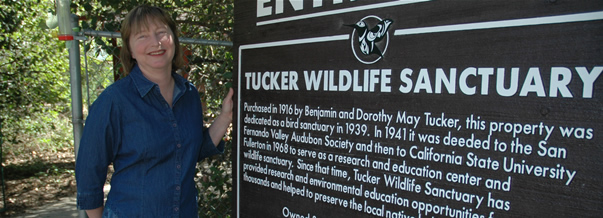Close to Nature
Marcella Gilchrist Calls Managing Tucker Wildlife Sanctuary Her Dream Job
June 25, 2007
By Russ Hudson
“Being here is a dream job,” was the immediate, simple, straightforward response when Marcella Gilchrist was asked how she likes her new position as site manager of the Tucker Wildlife Sanctuary in Modjeska Canyon. The sanctuary is owned and operated by Cal State Fullerton and its College of Natural Sciences and Mathematics (NSM).
“I’m up and moving by 7 a.m. and usually don’t stop again until 6 p.m., often later. It takes a couple of hours for us to feed the birds. We go through about 500 pounds of bird food a month. Then we clean the small-animal cages and give them food and water, sweep the trails and make sure they’re safe for visitors, tend the greenhouse, water the plants, sweep the observation porch, clean windows, work an hour or two on eradication of non-native plant species and the re-planting of native species, and do some maintenance on the buildings.
“Mixed throughout this is some marketing and fund raising for
the sanctuary, sometimes shopping for supplies at Costco — which
is a bit of a drive from here — occasionally working with the
neighbors on some of their projects just as they help with the sanctuary,
and, of course, we’re open to the public from 9 a.m. to 4 p.m.
Tuesday through Sunday except on some holidays. A lot of groups of kindergarten
through sixth-grade students come through here to enjoy and learn about
nature. There are special events, such as birthday parties, astrology
nights and contests, and there are the professors and students from
Cal State Fullerton and other schools coming here to do research. There
aren’t really any days off.
“But, you know what? It’s easy to do when you live here. And, wow,
you couldn’t ask for a better place to work.”
Gilchrist’s workplace is 12 acres at 1,600 feet elevation at the end of Modjeska Canyon Road. Besides the people, it is populated by free-roaming squirrels, raccoons, opossums, snakes, lizards, occasionally a bobcat, sometimes mule deer and many birds, ranging from raptors to robins to finches to hummingbirds. Tended by the staff is a one-eared possum that was rescued long ago when it was found severely injured. It has its own home now, as do tortoises and, in two ponds that are scheduled to be drained, cleaned and refilled this summer, several turtles.
Also on the grounds is the 60-year-old Isaac Walton Amphitheatre, which will be refurbished so it can be used for nature talks again; a small natural history museum and interpretive center; an observation porch for watching the many native and migrating birds; picnic areas with tables; hiking paths; a gift shop; restrooms; parking; a natural streambed that has water in the winter; and the caretaker’s house, where Gilchrist lives.
All of those facilities need maintenance, and Eagle Scouts need projects to earn their badges. It is a well-made match, Gilchrist says. “We even have an Eagle Scout with the project of marketing Tucker Sanctuary to other Eagle Scouts to come here for their projects,” she said.
Gilchrist also approaches businesses, organizations and corporations for donations of supplies, equipment, labor and, of course, money – “I have no problem with walking around with my hand out for this place.” — and Tucker’s neighbors like having the sanctuary there. That is why many volunteer to help with upkeep and, in return, Tucker staff — Gilchrist, Armando de la Fuentes and Amanda Weis — will help them. Even the county has helped, supplying fish for the ponds that eat mosquito larvae, and Cal State Fullerton students have chosen projects for class that also benefit the sanctuary: “I have two geography students now who are mapping the site, and other students have done transects of the plants in the surrounding hills so we have a sort of inventory of what grows here and where.”
Besides the inclination to work with nature, Gilchrist has the background for the job. As she puts it, it was almost as if she had been training just for this position. She earned an associate degree in 2002 in environmental science, with an emphasis on native flora and fauna, from nearby Saddleback College; a bachelor’s degree in 2004 in geography from Call State Fullerton, with an emphasis in environmental analysis, and a master’s degree, also from Fullerton, in geography in 2006, with an emphasis in environmental education. She had a 4.0 grade point average throughout her college career and graduated summa cum laude from Fullerton in 2004 as well as being named an outstanding graduate. She also graduated summa cum laude from Saddleback, and she earned her Park Naturalist certificate and Habitat Restoration certificate there.
Besides her education, she was a volunteer with the California Department of Fish and Game, worked with The Nature Conservancy on a biological assessment of Santa Cruz Island, was on a water-monitoring project at Audubon Starr Ranch and worked with the U.S. Fish and Wildlife Service in surveying endangered species.
Now, though, she said, she is focused on this job. Then she thought of one more thing she did for the sanctuary: “Oh, and once a week I actually go to the Cal State Fullerton campus to do some paperwork.”


 Produced by the Office of Public Affairs at California State University, Fullerton.
Produced by the Office of Public Affairs at California State University, Fullerton.